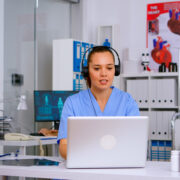Fascinating Technology That Is Helping Nursing Students Be More Prepared for Patient Care

Patient care is one of the most important skills that nurses use on the job. It’s also one that can be hard to pick up through book learning alone. How can a dusty old textbook teach you empathy, or how to work well under pressure?
Newly emerging technologies are making it easier for nurses to experience the pressures of working in a hospital setting without any of the high stakes. In this article, we take a look at technological breakthroughs that are changing the way nurses learn how to care for patients.
Virtual Reality (VR) Simulations in Nursing Education
Virtual reality experiences give nursing students an unprecedented level of digital immersion when it comes to educational training. These programs can replicate a wide range of healthcare scenarios. One benefit is that they give students the opportunity to experience some of the pressures of emergency situations without any of the same stakes. The student is able to administer their intervention and respond as life-like variables emerge. It’s a great way to hone skills and develop critical thinking on the fly.
VR also gives students the opportunity to experience rare situations that might not come up organically while they are doing their clinical rotations. Hospital experience is a vital part of training for nurses, but one of its limitations is also its strongest asset: you never know what will happen. This lack of predictability helps train nurses for professional life, but it also can result in gaps in their education. VR can potentially help fill those gaps, introducing nurses to situations that they can tap into later on in the job.
Though VR is growing significantly, it isn’t completely convincing. However, the technology changes every day, becoming both more realistic and accessible. In the not-so-distant future, it’s easy to imagine a situation where nursing students have access to high-quality VR at home and at school.
Interactive Learning Platforms and Mobile Applications
Interactive learning platforms provide quizzes with feedback administered in real-time. They may also include highly detailed 3D models that allow students to get a highly sophisticated look at anatomical structures that books simply can’t provide.
These programs also often feature study aids that make it easier for nursing students to learn in the way that is most natural to them. For example, flashcards, cultivated study guides, and learning materials presented through multiple media sources (written text, video, audio, etc.). Digital learning modules are flexible and versatile, allowing students to enjoy a bespoke learning experience that wasn’t possible even ten years ago.
EHR and Data Implementation
Nursing students are also actively learning about digital technology developments that have had a significant impact on how care is administered in modern hospitals. One of these new technologies is electronic health records (EHR). Electronic health records allow patients to view all of their health data from the comfort of their phones.
It makes it easy to pass patient information from one hospital or clinic to the next. They can be lifesaving for patients who now have instant access to their entire health history.
That said, they do come with a learning curve. Learning about this technology in school prepares nurses for the technological landscape they will enter when they begin their careers.
Data processing and implementation is another core technological skill that students learn in college. It relates directly to patient care, giving nurses the tools they need to process and understand insights derived from electronic health records and other valuable sources.
Simulation Labs
Simulation labs provide an experience similar to what students using virtual reality encounter. The difference? Simulation labs are physical locations that look identical to hospital rooms or ERs. They usually feature flexible configurations that can be adapted depending on the situation that is being simulated.
Students interact with mannequins that can simulate human conditions, including a discernable pulse and life-like temperature.
These labs are often used to accomplish several things:
- Test the student’s knowledge in a risk-free environment: Like VR, simulation labs replicate hospital experiences without requiring any of the risks. It’s a great way to get a feel for the stakes of nursing without risking anyone’s health.
- Encourage collaboration: Teamwork is vital in the hospital setting. Students who work in simulation labs get the chance to test their communication skills while experiencing the pressures of patient care.
- Adaptability: Simulation labs also help grow the students’ adaptability by constantly adjusting the scenario being presented. In real life, things change at the drop of the hat. This spontaneity can be difficult to induce within the classroom but comes alive in the adjustable simulation lab setting.
Simulation labs are costly and not every school has them. However, as the technology behind this intriguing educational tool proliferates, it will become increasingly more accessible to nursing students all across the country.
Telehealth Training
The rise of telehealth technology is making healthcare more accessible. Now, people with mobility problems can avoid unnecessary trips to the doctor by handling basic questions online. Nurses and doctors monitor electronic communication channels like MyChart, and provide responses to simple questions remotely, usually within 1-2 days.
Nurses are now trained with telehealth technology, giving them practical experience in administering patient care.
This remote training also gives nursing students the opportunity to work with a wider variety of doctors, nurses, and healthcare mentors. Where once nursing students would be limited to instructors at their physical location, they can now connect with professionals all over the country, significantly increasing their network.
Conclusion
Technology cannot eliminate the need for human connections. All of the simulations in the world can’t fully prepare someone for the experience of breaking bad news to a patient or their family. It can’t get you ready to watch a person weep or have them scream their head off at you because they have no other outlet for their feelings.
Hospitals are home to some of the most challenging human interactions imaginable. They are where life begins and ends for most people. That’s a heavy proposition.
But while digital technology can’t completely get future nurses ready for what is ahead of them, it can serve as a low-risk tool for learning the tricks of the trade. It’s an accessible way to learn and train better and more efficiently than ever before.









Leave a Reply
Want to join the discussion?Feel free to contribute!